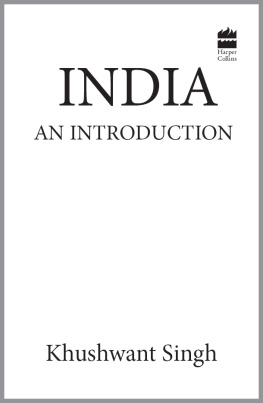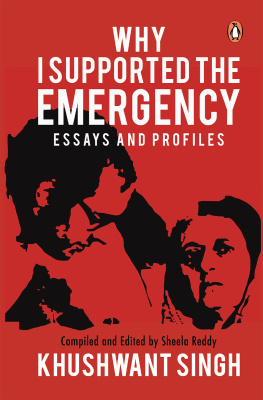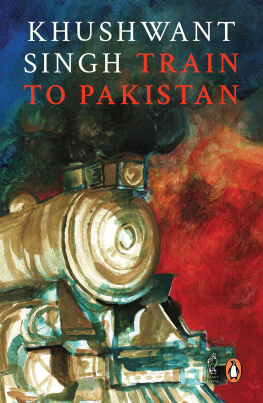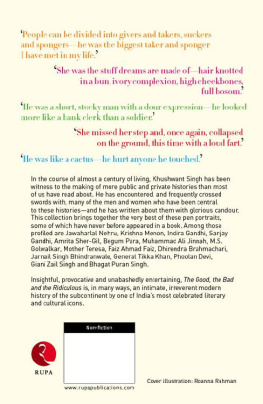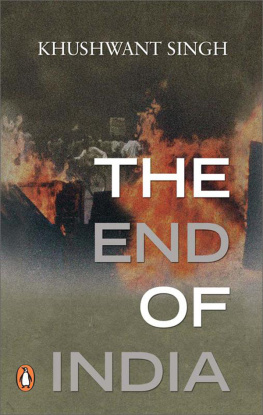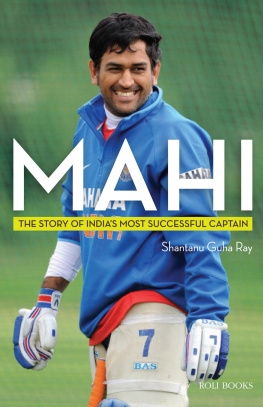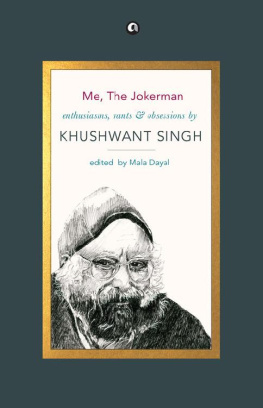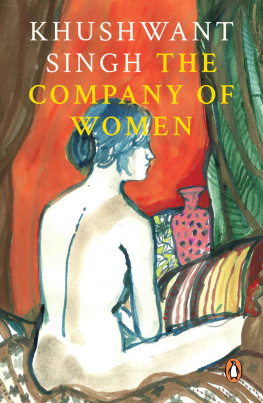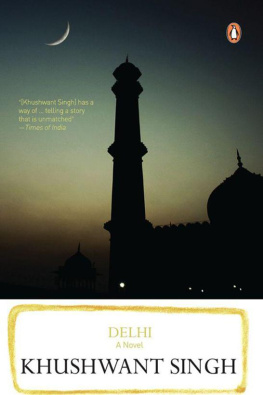
INDIA AN INTRODUCTION
Khushwant Singh

Table of Contents
I learnt more about India teaching Indian history and religions to American students at Princeton, Swarthmore and Hawaii than I could have attending lectures in an Indian University. I was a poor student and imbibed very little learning from my professors. When the rules were reversed and instead of sitting in class among students I had to face them alone standing on the podium, I had to garner all the information I could, poring over books in the library, arranging it in a presentable order and prepare myself to answer questions that might be put to me. It proved to be a most daunting and exhausting task. The seminar system which had just come into vogue during my teaching years at American Universities required even more study and face to face confrontation with young and bright minds full of enquiry and passion for learning. I can echo the opinion of Rabbi Hillel when he said, I have learned much from my teachers, still more from my colleagues, but from my pupils more than from all of them.

Fortunately I kept notes of lectures I had to prepare. Some years after I had quit teaching and taken up the editorship of The Illustrated Weekly of India in Bombay, I found these notes helpful in writing articles for my own journal and several others when I was commissioned to write for The New York Times. Since these articles were not for learned audiences but for readers of newspapers and journals I had to teach myself how to communicate with the common man in the street: to explain Hinduism to people who can't be bothered to read the Vedas, Upanishads, the epics and the Gita; to explain Islam to non-Muslims who are never likely to read a biography of Prophet Mohammed, the Quran and the Hadith. And so on. At the same time I felt there were simple things like ethnie names, customs and rituals, peculiar dresses which marked religious communities from each other. Why, for instance, Iyers who are Saivites wear a particular form of caste-mark on their foreheads than Iyengars who are Vaishnavites; why all Sikhs are Singhs but not all Singhs are Sikh; why Sikhs wear turbans and what, if anything, the colour of their headwear signifies; why some Jains go stark naked while other do not; why all are strict vegetarians and some even refrain from eating vegetables like potatoes, onions and garlic, which grow under the ground.
It was after going over my college lectures many times, adding to them and bringing them uptodate that I decided to put them in the form of a book, a sort of introduction to India its colourful peoples, its potted history, its religions, its politics and its literature. Specialists may find fault with such a broad sweep. But this book is not meant for them but for the intelligent, enquiring layman who wants to know more about India and has no time to pore over large tomes of books of learning.
It may appear like an instant-India version of instant coffee, but I hope there is more to it than that. If it lights a spark of interest in my reader's mind so that he would like to further pursue his studies in India, my hopes will have been fulfilled.
New Delhi
Khushwant Singh
1
The Land and The People
T ake a Look at a map of the world and gauge the size of India. It is the seventh largest country in the world and, after China, the second largest in Asia. Covering an area of 1,127,000 square miles, it extends over 2,000 miles from north to south and 1,700 miles from east to west. It has land frontiers with Pakistan, Russia, China, Bangladesh, Nepal and Burma which stretch over 8,200 miles across deserts, mountains and tropical forests. Its coastline is over 3,500 miles long.
India has three major zones the Himalayas, the Indo-Gangetic plain and the Deccan plateau. Before the creation of Pakistan, the subcontinent had a geographical unity, with mountain ranges forming the frontiers of the north and the west. The importance of these mountains lay in their impassability. They are the highest in the world Mount Everest rising to 29,028 feet and most of them are snowbound throughout the year, as indeed, their name, Hima (snow) alaya (the abode) signifies. Of greater historical importance than the towering heights and the perennial snows were the few passes which made the Himalayas passable and, like sluice gates of a dam, provided regular inlets for the hordes that lived on the other side. Passes like the Bolan, Khurram and Khyber are in the north-west; there are many others which link India with Tibet. These passes were known to nomads and shepherds who grazed their flocks of sheep and goats in the valleys, to tradesmen who brought their caravans of merchandise through them and, of course, to marauders who used them to invade and loot the rich plains of India.

The Himalayas
The history of India is monotonous and tragic repetition of invasions through the Himalayan passes. The timing was fixed with calendar-like precision. The invader got his forces together just before autumn, crossed the passes before snowfall and swept down on the Indian plains in early winter when the skies were blue, the air cool and fragrant with the smell of mustard, green wheat and sugarcane. Most of the battles between the invaders and the Indians were fought in the Punjab and if the invaders were victorious, which they often were, they spent the winter months systematically looting the cities Lahore, Karnal, Panipat, Delhi, Mathura, Agra. Before the summer's heat came on, they carried away the harvested winter crops, retraced their steps, and disappeared into the mountain passes through which they had come.
While the Himalayas gave Indians the illusion of being guarded by an impassable wall, the Indo-Gangetic plain gave them the illusion of owning an inexhaustible granary. About 70,000 square miles in area, the plain is one of the world's longest alluvium tracts. Cities, towns and villages cover it, one within sight of the other. The States of Uttar Pradesh, Bihar and West Bengal, for instance, have about six times the density of population obtaining in the United States of America. When the monsoon fails, districts of eastern Uttar Pradesh, Bihar and Orissa become like the dust bowl of Rajasthan, unable to feed their millions.
The third great divide is the Deccan plateau. The region is like a vast triangle; the low-lying ghats running along the sea coast form two sides, while the hill ranges of the Vindhya and Satpuras, with the rivers Narmada and Tapti, mark it off from the north. Though the region has geographical identity, it is inhabited by two racial groups. The northern half, describing itself as Deccani, speaks languages which are closely related. The southern half is inhabited by Dravidians speaking Dravidian languages: Telugu, Tamil, Kannada and Malayalam. Indians talk of these three parts of India as the head, the torso and the groin-and-legs of the one entity that is India. They visualise it as Mother India with her head in the snowy Himalayas, her arms stretched from the Punjab to Assam, her ample bosom and middle (the Indian concept of feminine beauty requires a woman to be big-breasted and heavy-hipped) resting on the Indo-Gangetic plain and the Deccan, and her feet bathed by the waters of the Indian Ocean. Sri Lanka is like a lotus-petalled foot-stool. This deified configuration of Mother India is often depicted by Indian artists as goddess Lakshmi, the goddess of plenty, or Saraswati, the patron goddess of the arts. In 1947, the Indian subcontinent had its eastern and western extremes lopped off to make the two wings of the State of Pakistan. Thereafter Mother India assumed the shape of a Venus de Milo.

